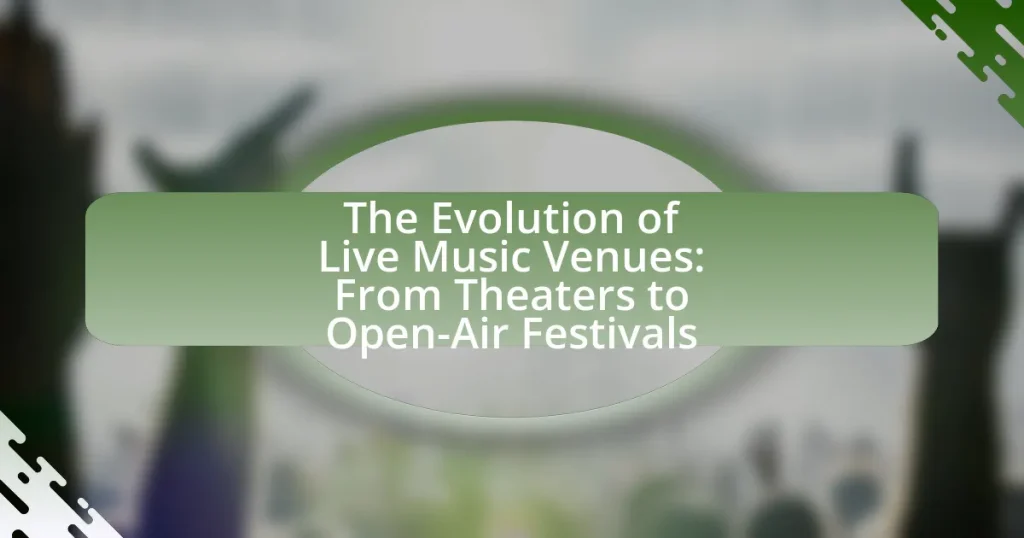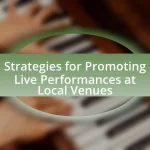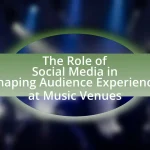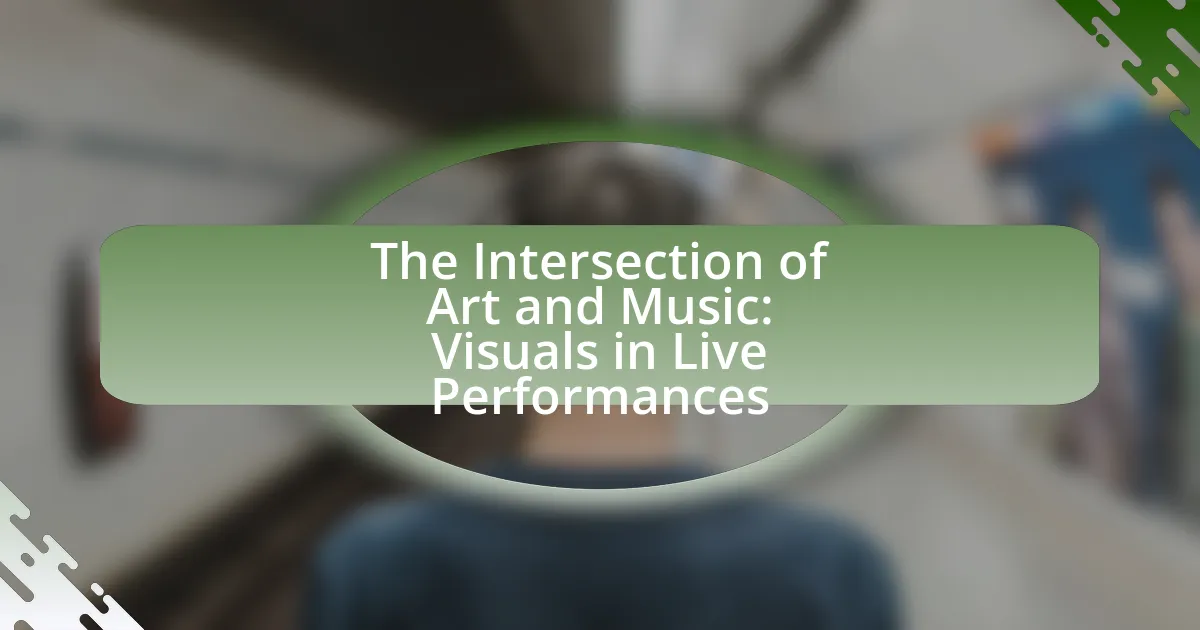The article examines the evolution of live music venues, tracing their development from 19th-century theaters to contemporary open-air festivals. It highlights key stages, including the rise of jazz clubs, rock and roll arenas, and multi-purpose stadiums, each reflecting cultural shifts and technological advancements. The discussion covers the architectural features of early theaters, the role of clubs in fostering new musical genres, and the impact of outdoor festivals on audience engagement. Additionally, it addresses current trends such as technology integration, sustainability practices, and the future prospects for live music venues in a post-pandemic landscape.

What are the key stages in the evolution of live music venues?
The key stages in the evolution of live music venues include the establishment of theaters in the 19th century, the rise of jazz clubs in the early 20th century, the emergence of rock and roll arenas in the 1950s and 1960s, the development of multi-purpose stadiums in the 1970s, and the growth of open-air festivals in the late 20th century. Theaters served as the primary venues for performances, accommodating orchestras and theatrical productions. Jazz clubs became popular for intimate performances, fostering a vibrant music scene. Rock and roll arenas catered to larger audiences, reflecting the genre’s explosive popularity. Multi-purpose stadiums allowed for massive concerts, while open-air festivals, such as Woodstock in 1969, revolutionized the live music experience by bringing together diverse acts and large crowds in outdoor settings. Each stage marked a significant shift in how live music was experienced and consumed, adapting to cultural trends and technological advancements.
How did theaters shape the early live music experience?
Theaters significantly shaped the early live music experience by providing structured environments for performances, enhancing acoustics, and fostering community engagement. The design of theaters, often featuring proscenium stages and audience seating, allowed for better sound projection and visibility, which improved the overall experience for both performers and audiences. Historical examples include the use of the Teatro di San Carlo in Naples, established in 1737, which became a model for opera houses worldwide, emphasizing the importance of architecture in live music. Additionally, theaters served as cultural hubs, where diverse musical genres could be showcased, thus influencing the development of various musical styles and traditions.
What architectural features defined early theaters for live music?
Early theaters for live music were characterized by a semi-circular seating arrangement, an elevated stage, and acoustic enhancements. The semi-circular seating allowed for optimal sightlines and sound distribution, facilitating audience engagement. The elevated stage, often framed by a proscenium arch, provided a clear focal point for performers and improved visibility. Acoustic enhancements, such as the use of materials like wood and stone, were employed to amplify sound, ensuring that music could be heard clearly throughout the venue. These architectural features were essential in creating an immersive experience for audiences, as evidenced by the design of ancient Greek theaters, which were specifically constructed to enhance both visual and auditory experiences for live performances.
How did the cultural context influence theater performances?
Cultural context significantly influenced theater performances by shaping themes, styles, and audience engagement. For instance, during the Renaissance, the revival of classical texts and humanist ideals led to a focus on individualism and complex characters in plays, reflecting societal values of the time. Additionally, the socio-political climate, such as the censorship in Elizabethan England, dictated the content and delivery of performances, often embedding subtle critiques of authority within the narratives. Historical events, like the French Revolution, also prompted shifts in theatrical expression, as playwrights began to explore themes of liberty and social justice, resonating with the public’s sentiments. These examples illustrate how cultural context directly impacts the evolution and nature of theater performances.
What role did clubs and bars play in the development of live music venues?
Clubs and bars were instrumental in the development of live music venues by providing accessible spaces for emerging artists to perform and connect with audiences. These establishments often served as incubators for new musical genres and local talent, allowing musicians to gain exposure and build a following. Historically, venues like the Apollo Theater in Harlem and the Whisky a Go Go in Los Angeles exemplified how clubs and bars could elevate live music, showcasing acts that later became mainstream successes. This grassroots support for live performances contributed significantly to the evolution of the music industry, fostering a culture where live music became a staple of social entertainment.
How did the rise of rock and roll impact club culture?
The rise of rock and roll significantly transformed club culture by shifting the focus from jazz and blues to a more energetic and youth-oriented music scene. This transition led to the establishment of smaller, more intimate venues that catered specifically to live rock performances, fostering a sense of community among young audiences. Clubs became essential spaces for social interaction, where fans could experience the music up close, contributing to the popularity of bands and artists. The 1950s and 1960s saw iconic clubs like the Whisky a Go Go in Los Angeles and the Fillmore in San Francisco emerge, which not only hosted legendary performances but also became cultural landmarks that shaped the identity of rock music. This evolution in club culture reflected broader societal changes, as youth began to assert their cultural influence, making clubs pivotal in the promotion and dissemination of rock and roll music.
What are the differences between clubs and theaters in terms of audience experience?
Clubs and theaters differ significantly in audience experience, primarily in terms of atmosphere and engagement. Clubs typically offer an intimate, energetic environment where audiences can dance and interact closely with performers, fostering a sense of community and immediacy. In contrast, theaters provide a more formal setting, emphasizing seated performances where the audience observes from a distance, creating a more passive experience.
The club experience often includes elements like DJ sets or live bands in a casual space, encouraging audience participation and movement, while theaters focus on scripted performances, such as plays or concerts, where the audience is expected to remain seated and attentive. This distinction is supported by research indicating that the physical layout and design of venues influence audience behavior and engagement levels, with clubs promoting active participation and theaters facilitating a more contemplative viewing experience.
How did the emergence of outdoor festivals change the live music landscape?
The emergence of outdoor festivals significantly transformed the live music landscape by creating large-scale, immersive experiences that attract diverse audiences. These festivals, such as Coachella and Glastonbury, have shifted the focus from traditional indoor venues to expansive outdoor settings, allowing for greater audience capacity and a festival atmosphere that combines music with art, food, and community engagement. This change has led to increased revenue opportunities for artists and promoters, with the global music festival market valued at approximately $26 billion in 2022, reflecting a growing trend in live music consumption. Additionally, outdoor festivals have fostered a sense of community and cultural exchange, as they often feature a variety of genres and artists from different backgrounds, enhancing the overall appeal and accessibility of live music.
What factors contributed to the popularity of open-air festivals?
The popularity of open-air festivals is primarily driven by their unique atmosphere and accessibility. Open-air festivals provide an immersive experience that combines music, nature, and social interaction, attracting diverse audiences. The rise of social media has amplified this trend, as attendees share their experiences online, creating a sense of community and excitement around these events. Additionally, the affordability of outdoor venues compared to traditional theaters allows for larger crowds, enhancing the festival experience. According to a report by the Eventbrite platform, 78% of millennials prefer attending outdoor events, highlighting the demographic shift towards open-air gatherings.
How do open-air festivals differ from traditional venues in terms of logistics?
Open-air festivals differ from traditional venues in logistics primarily due to their need for extensive infrastructure setup and management of outdoor elements. Unlike traditional venues, which typically have established facilities such as seating, restrooms, and sound systems, open-air festivals require temporary installations for stages, seating, and utilities, often needing significant lead time for setup and teardown. Additionally, open-air festivals must account for weather conditions, necessitating contingency plans for rain or extreme heat, which is less of a concern in controlled indoor environments. This logistical complexity is evidenced by the fact that major festivals like Coachella and Glastonbury can take several months to plan and require coordination with local authorities for permits, crowd control, and emergency services, highlighting the unique challenges faced in outdoor settings compared to traditional venues.
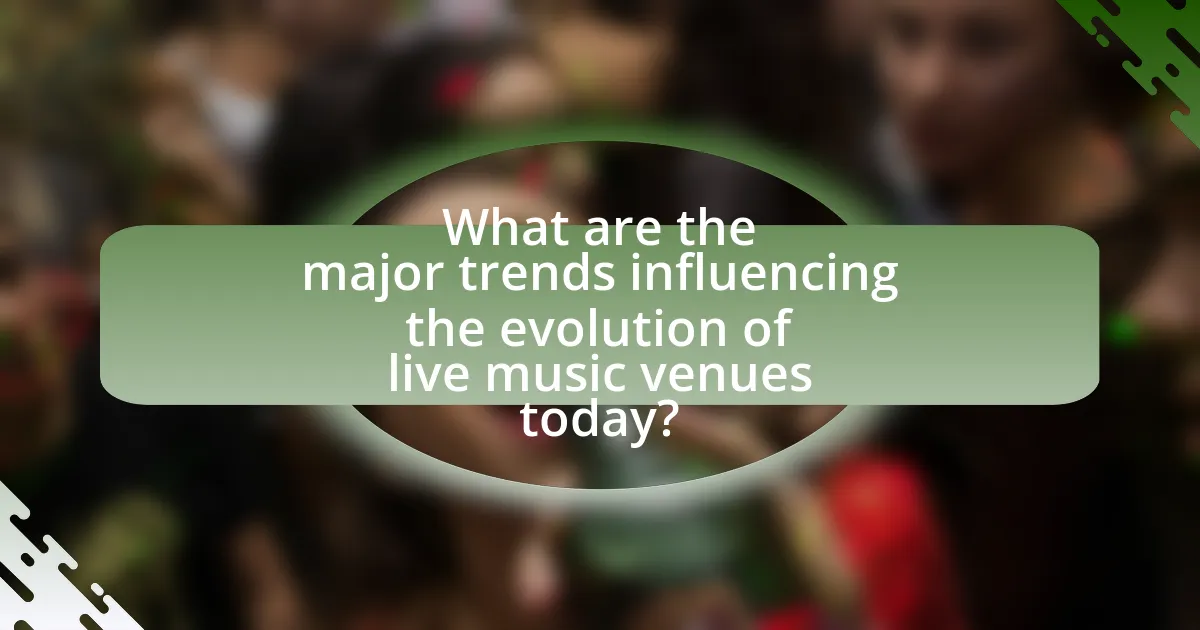
What are the major trends influencing the evolution of live music venues today?
The major trends influencing the evolution of live music venues today include the integration of technology, a focus on sustainability, and the rise of experiential events. Technology has transformed live music experiences through advancements in sound systems, lighting, and streaming capabilities, allowing venues to reach wider audiences and enhance the overall experience. Sustainability is increasingly prioritized, with venues adopting eco-friendly practices such as waste reduction and energy efficiency to appeal to environmentally conscious audiences. Additionally, the rise of experiential events, which combine music with unique themes and interactive elements, has reshaped how venues attract and engage attendees, reflecting a shift towards creating memorable experiences rather than just hosting performances.
How has technology transformed the live music experience?
Technology has significantly transformed the live music experience by enhancing sound quality, enabling immersive visuals, and facilitating audience engagement. Advanced sound systems, such as line array speakers, provide clearer audio across large venues, ensuring that every attendee can enjoy high-fidelity sound. Additionally, visual technologies like LED screens and projection mapping create dynamic backdrops that enhance the overall atmosphere of performances. Furthermore, technology has enabled real-time audience interaction through mobile apps and social media, allowing fans to participate in live polls or request songs, thereby increasing engagement and creating a more personalized experience. These advancements illustrate how technology has reshaped live music, making it more accessible and enjoyable for diverse audiences.
What role do social media and streaming play in promoting live events?
Social media and streaming play a crucial role in promoting live events by enhancing visibility and engagement. Platforms like Facebook, Instagram, and Twitter allow event organizers to reach a broader audience through targeted advertising and organic sharing, significantly increasing ticket sales and attendance. For instance, a study by Eventbrite found that 80% of event organizers use social media to promote their events, leading to higher engagement rates and increased awareness. Streaming services also provide a means for live events to reach audiences who cannot attend in person, as seen with platforms like YouTube Live and Twitch, which have hosted major concerts and festivals, expanding their reach to millions globally. This dual approach of leveraging social media for promotion and streaming for accessibility has transformed how live events are marketed and experienced.
How has sound technology evolved in live music venues?
Sound technology in live music venues has evolved significantly from basic amplification systems to advanced digital audio technologies. Initially, venues relied on simple microphones and analog mixers, which limited sound quality and control. The introduction of digital mixing consoles in the late 20th century allowed for greater precision in sound manipulation, enabling engineers to manage multiple audio sources with enhanced clarity.
Furthermore, the development of line array speaker systems revolutionized sound distribution, providing even coverage across large audiences and minimizing distortion. According to a study by Meyer Sound, line array technology can improve sound quality by up to 30% compared to traditional speaker setups. Additionally, advancements in wireless technology have facilitated the use of in-ear monitors, allowing performers to hear themselves clearly without the interference of stage noise.
Overall, these technological advancements have transformed live music experiences, enhancing both performer and audience satisfaction through improved sound quality and control.
What impact do economic factors have on the viability of live music venues?
Economic factors significantly influence the viability of live music venues by affecting their operational costs, revenue generation, and overall sustainability. For instance, fluctuations in disposable income can directly impact ticket sales, as consumers are less likely to spend on entertainment during economic downturns. Additionally, rising costs of rent, utilities, and staffing can strain the financial resources of these venues, making it challenging to maintain profitability. According to a 2021 report by the National Independent Venue Association, 90% of independent venues reported that they faced severe financial challenges due to the pandemic, highlighting the critical role of economic conditions in their survival. Thus, economic factors are pivotal in determining whether live music venues can thrive or face closure.
How do ticket prices affect audience attendance at live events?
Ticket prices significantly influence audience attendance at live events, with higher prices often leading to decreased attendance. Research indicates that price elasticity of demand for live events is typically negative, meaning as ticket prices rise, the number of attendees tends to fall. For instance, a study by the National Bureau of Economic Research found that a 10% increase in ticket prices can result in a 5% to 10% decrease in attendance, highlighting the sensitivity of audiences to pricing. Additionally, events with lower ticket prices tend to attract a broader demographic, increasing overall attendance.
What are the financial challenges faced by smaller venues compared to larger ones?
Smaller venues face significant financial challenges compared to larger ones, primarily due to limited revenue streams and higher per-capita costs. Smaller venues often struggle with lower ticket sales, as they have a reduced capacity, which directly impacts their ability to cover fixed costs such as rent, utilities, and staffing. According to a study by the National Independent Venue Association, 90% of independent venues reported that they operate on thin margins, making them more vulnerable to economic fluctuations. Additionally, smaller venues typically lack the bargaining power to negotiate better terms with suppliers and artists, leading to higher operational costs. This financial strain is exacerbated by competition from larger venues that can offer more attractive packages to artists, further diminishing the smaller venues’ ability to attract high-profile acts.
How are sustainability practices being integrated into live music venues?
Sustainability practices are being integrated into live music venues through initiatives such as waste reduction, energy efficiency, and sustainable sourcing. Many venues are implementing recycling programs and composting to minimize waste, with some reporting up to 90% waste diversion rates. Additionally, energy-efficient lighting and sound systems are being adopted, which can reduce energy consumption by 30% or more. Venues are also prioritizing local and organic food vendors, thereby supporting sustainable agriculture and reducing carbon footprints associated with food transportation. These practices not only enhance environmental responsibility but also resonate with audiences increasingly concerned about sustainability, as evidenced by surveys indicating that over 70% of concertgoers prefer venues that demonstrate eco-friendly practices.
What initiatives are venues taking to reduce their environmental impact?
Venues are implementing various initiatives to reduce their environmental impact, including adopting renewable energy sources, enhancing waste management practices, and promoting sustainable transportation options. For instance, many venues are installing solar panels to generate clean energy, which significantly lowers their carbon footprint. Additionally, they are increasing recycling and composting efforts to minimize landfill waste, with some venues reporting up to 75% waste diversion rates. Furthermore, venues are encouraging attendees to use public transport or carpooling, often providing incentives such as discounts for those who do. These initiatives collectively contribute to a more sustainable live music experience.
How does sustainability influence audience perception of live music events?
Sustainability significantly enhances audience perception of live music events by aligning with their values and expectations for environmental responsibility. Audiences increasingly prefer events that demonstrate eco-friendly practices, such as waste reduction, renewable energy use, and sustainable sourcing of materials. Research conducted by the Event Industry Council indicates that 74% of attendees are more likely to support events that prioritize sustainability. This preference not only boosts attendance but also fosters a positive emotional connection to the event, as audiences feel they are contributing to a greater cause. Consequently, live music events that incorporate sustainable practices are perceived as more innovative and socially responsible, leading to increased loyalty and positive word-of-mouth among attendees.
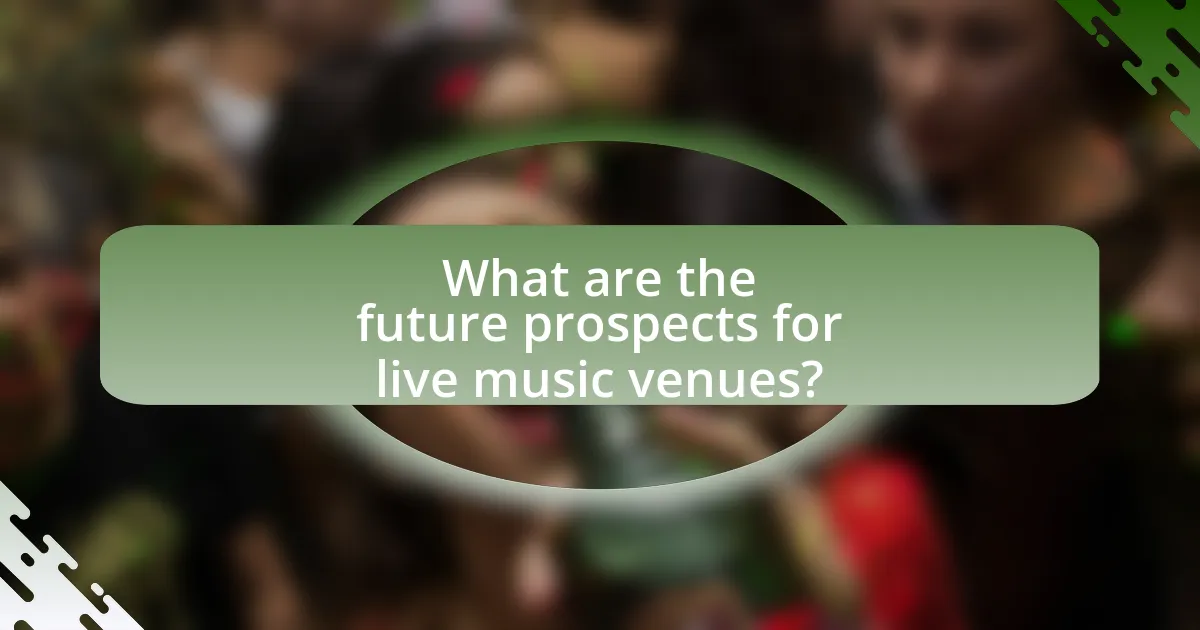
What are the future prospects for live music venues?
The future prospects for live music venues are promising, driven by a resurgence in audience demand and innovative adaptations to changing circumstances. As of 2023, live music venues are increasingly incorporating technology, such as virtual reality and enhanced sound systems, to create immersive experiences that attract diverse audiences. Additionally, the growth of outdoor festivals and hybrid events, which combine in-person and virtual attendance, reflects a strategic shift to accommodate varying consumer preferences. According to a report by Pollstar, the global live music industry is projected to reach $31 billion by 2025, indicating robust growth potential. This data underscores the resilience and adaptability of live music venues in the evolving entertainment landscape.
How might the COVID-19 pandemic reshape live music venues in the long term?
The COVID-19 pandemic may reshape live music venues in the long term by accelerating the adoption of hybrid models that combine in-person and virtual experiences. This shift is driven by the need for venues to adapt to health guidelines and audience preferences for safety and accessibility. For instance, many venues have started implementing enhanced ventilation systems and contactless technologies to ensure safety, which may become standard practices. Additionally, the rise of live-streaming concerts during the pandemic has shown that audiences are willing to engage with performances online, leading venues to consider permanent virtual components to their offerings. This evolution reflects a broader trend towards flexibility and innovation in the live music industry, as venues seek to attract diverse audiences and maximize revenue streams.
What safety measures are likely to become standard in live music venues?
Enhanced crowd management protocols are likely to become standard in live music venues. These protocols will include the implementation of advanced ticketing systems to control entry and exit, increased staff training for emergency situations, and the use of technology such as facial recognition for security purposes. According to a report by the National Independent Venue Association, 70% of venues plan to adopt stricter safety measures post-pandemic, highlighting a significant shift towards prioritizing audience safety.
How has audience behavior changed post-pandemic regarding live events?
Audience behavior regarding live events has shifted significantly post-pandemic, with increased demand for outdoor venues and a preference for smaller, more intimate gatherings. Research indicates that 70% of attendees now prioritize safety measures, such as social distancing and enhanced sanitation, when choosing events. Additionally, many individuals have developed a greater appreciation for the experience of live performances, leading to a willingness to pay higher ticket prices for unique and memorable events. This change reflects a broader trend towards valuing personal health and safety while seeking meaningful social interactions in the context of live entertainment.
What innovations could define the next generation of live music venues?
The next generation of live music venues could be defined by innovations such as advanced immersive technologies, sustainable design practices, and enhanced audience engagement platforms. Advanced immersive technologies, including augmented reality (AR) and virtual reality (VR), can create interactive experiences that allow audiences to engage with performances in novel ways, as evidenced by the increasing use of AR in concerts to enhance visual storytelling. Sustainable design practices, such as energy-efficient systems and eco-friendly materials, are becoming essential as venues aim to reduce their carbon footprint; for instance, the use of solar panels and rainwater harvesting systems has been adopted by several new venues. Enhanced audience engagement platforms, utilizing mobile apps and social media integration, can facilitate real-time interaction and feedback, improving the overall concert experience and fostering community among attendees. These innovations collectively represent a shift towards more interactive, environmentally conscious, and technologically integrated live music experiences.
How might virtual reality and augmented reality enhance live music experiences?
Virtual reality (VR) and augmented reality (AR) can significantly enhance live music experiences by creating immersive environments that engage audiences in novel ways. VR allows users to experience concerts from various perspectives, such as front-row seats or backstage access, regardless of their physical location. This technology can simulate the atmosphere of a live event, making viewers feel as if they are part of the performance. AR, on the other hand, can overlay digital elements onto the real-world environment, enriching the concert experience with interactive visuals and information about the artists or songs being performed. For instance, during a live show, AR can project visuals that sync with the music, enhancing emotional engagement and providing a multi-sensory experience. Studies have shown that immersive technologies can increase audience satisfaction and engagement, as evidenced by events like the virtual Coachella festival, which attracted millions of viewers globally, demonstrating the potential of VR and AR to transform how audiences experience live music.
What new formats for live music events are emerging in response to audience demand?
New formats for live music events emerging in response to audience demand include hybrid concerts, drive-in shows, and virtual reality experiences. Hybrid concerts combine in-person attendance with live streaming, allowing broader access and engagement, as seen during the COVID-19 pandemic when artists like Travis Scott hosted virtual concerts in video games, attracting millions. Drive-in shows have gained popularity, providing a safe environment for audiences to enjoy live music from their vehicles, with events like the “Drive-In Concert Series” in various cities demonstrating this trend. Virtual reality experiences offer immersive environments for fans, enabling them to attend concerts from home, exemplified by platforms like Oculus Venues, which host live performances in virtual spaces. These formats reflect a shift towards flexibility and safety in live music experiences.
What best practices can venue operators adopt to thrive in the evolving landscape?
Venue operators can thrive in the evolving landscape by embracing technology, enhancing customer experience, and diversifying revenue streams. Implementing advanced ticketing systems and utilizing data analytics allows operators to understand audience preferences and optimize marketing strategies. For instance, venues that adopted mobile ticketing saw a 30% increase in sales efficiency, according to a study by Eventbrite. Additionally, creating immersive experiences through interactive elements and high-quality production can attract larger audiences, as evidenced by the success of festivals that incorporate unique visual and auditory elements. Finally, diversifying revenue through merchandise sales, food and beverage offerings, and hosting a variety of events can stabilize income, as venues that offer multiple event types report a 25% increase in overall revenue.
